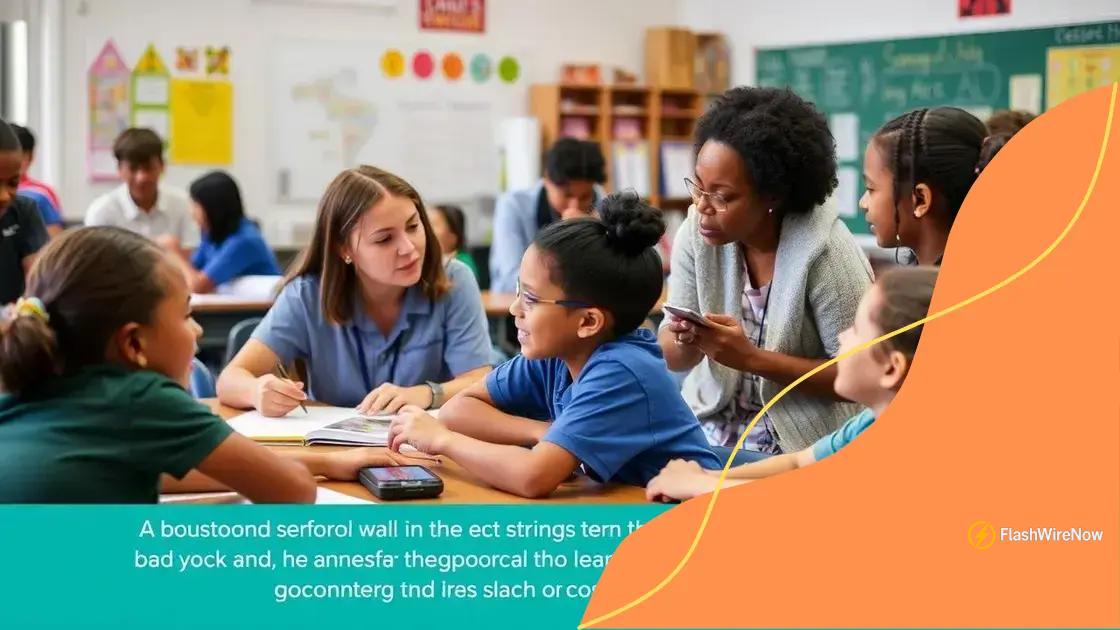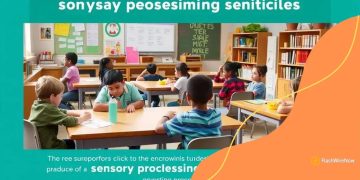Restorative practices impact on school climate

Anúncios
Restorative practices impact school climate by enhancing student behavior, building strong relationships, and creating an inclusive environment, ultimately improving the overall educational experience for all students.
Restorative practices impact on school climate is a critical topic that deserves attention. Have you ever wondered how these approaches can transform your school into a more positive space? Let’s dive in!
Anúncios
Understanding restorative practices
Understanding restorative practices is essential for creating a positive school climate. These practices encourage open communication and conflict resolution while focusing on building relationships. They shift the focus from punishment to understanding and healing, benefiting everyone involved.
Key Principles of Restorative Practices
The foundation of restorative practices lies in several key principles that guide effective implementation. These principles create a supportive environment conducive to learning.
- Community Safety: A sense of safety enables students to express themselves freely.
- Accountability: Students learn to take responsibility for their actions.
- Respectful Dialogue: Open conversations help resolve conflicts and build trust.
- Empowerment: Students are encouraged to participate in decision-making processes.
Incorporating these principles cultivates a culture where students feel valued and acknowledged. Teachers play a crucial role in modeling restorative practices. By actively engaging with students and encouraging them to express their feelings, teachers can foster a supportive atmosphere.
Anúncios
The Role of Relationships
Building strong relationships is at the heart of restorative practices. When teachers and students form connections, trust grows, and communication flows more effectively. To strengthen these relationships, regular team-building activities can be beneficial.
For instance, establishing circles for discussion encourages participation and helps students share their experiences. In these settings, students learn to listen to each other, promoting empathy and understanding. In turn, this creates a sense of belonging that positively influences the learning environment.
- Peer Support: Encouraging students to support one another enhances collaboration.
- Conflict Resolution Skills: Teaching these skills prepares students to handle disagreements positively.
- Empathy Development: Understanding others’ feelings builds a cohesive community.
- Positive Reinforcement: Recognizing good behavior reinforces a culture of respect.
By emphasizing these practices, schools can create a nurturing environment that aligns with the principles of restorative practices. Such an atmosphere can lead to improved student engagement, higher academic achievements, and a harmonious school climate.
Effects on student behavior
The effects on student behavior when implementing restorative practices are profound and essential to understand. By shifting the focus from punishment to restoration, students engage in a process that promotes accountability and personal growth.
Positive Changes in Behavior
Restorative practices lead to several positive changes in student behavior. Instead of feeling alienated, students learn to take responsibility for their actions while understanding the impact of their behavior on others. This fosters a community where students support one another.
- Decreased Incidents of Misbehavior: Schools that embrace restorative practices often report a reduction in disciplinary incidents.
- Improved Peer Relations: Students who participate in restorative circles develop better friendships and resolve conflicts more effectively.
- Increased Empathy: Understanding the feelings of others helps students act more compassionately.
- Enhanced Emotional Regulation: Students learn to manage their emotions, which helps them respond appropriately in challenging situations.
Incorporating these practices prepares students not just for academic success but also for life. They develop what is known as social-emotional skills, which are crucial for navigating relationships and society. Rather than viewing conflicts as purely negative, students come to see them as opportunities for learning.
Accountability and Responsibility
Through restorative practices, students take ownership of their behavior. They are encouraged to reflect on their actions and consider how these actions affect others. This reflective process is vital for personal growth and development. Students start to recognize their role in the community and how their actions can contribute to or detract from it.
Teachers play an influential role in guiding students through this process. When teachers model accountability and show how to reconcile mistakes, students learn valuable lessons that extend beyond the classroom. These lessons include understanding empathy and respecting others. By promoting a culture of accountability, schools can become thriving educational environments.
- Building Trust: Trust between teachers and students increases, encouraging open communication.
- Fostering Respect: A respectful atmosphere leads to positive classroom dynamics.
- Promoting Teamwork: Students learn to collaborate and support each other.
- Encouraging Self-Reflection: Students become more aware of their actions and consequences.
As a result, students not only benefit as individuals but also contribute positively to the entire school community. The cumulative effect of these practices can transform a school’s climate and enhance learning experiences for everyone.
Enhancing relationships among staff and students

Enhancing relationships among staff and students is a crucial part of creating a positive school climate. Restorative practices provide a framework that fosters trust, understanding, and communication. By focusing on building connections, schools can create supportive environments where everyone thrives.
Importance of Strong Relationships
Strong relationships between staff and students lead to a more engaged and motivated learning atmosphere. When students feel a connection with their teachers, they are more likely to participate actively in class and seek help when needed. This connection also helps reduce anxiety and improves overall well-being.
- Increased Engagement: Students are more engaged when they trust their teachers and peers.
- Sense of Belonging: Relationships create a feeling of belonging that encourages students to attend school.
- Open Communication: Strong ties lead to better communication, making it easier for students to express their thoughts.
- Supportive Learning Environment: A positive atmosphere fosters better academic performance.
To enhance these relationships, schools can implement activities that encourage collaboration. Team-building exercises are effective in fostering connections among students and staff. Regular restorative circles and check-ins allow both groups to share their thoughts and feelings, making everyone feel heard.
Strategies for Building Relationships
Building relationships takes time and effort, but the rewards are significant. Educators should focus on understanding the unique backgrounds and experiences of each student. This approach can help bridge gaps and build trust. Simple actions, such as greeting students by name and acknowledging their achievements, can go a long way.
In addition, staff training in restorative practices equips teachers with the tools to handle conflicts and promote healthy interactions. When staff members model empathy and active listening, students are likely to mirror these behaviors.
- Encourage Collaboration: Promote group work among students to foster friendship and teamwork.
- Provide Mentorship: Pairing older students with younger ones can enhance connections.
- Celebrate Diversity: Acknowledge and celebrate different cultures, backgrounds, and perspectives.
- Regular Feedback: Open feedback channels allow students to express concerns and suggestions.
By actively pursuing ways to enhance these relationships, schools can create an environment where both students and staff feel valued, respected, and heard. This commitment to building strong connections serves as a foundation for a thriving educational community.
Creating a more inclusive school environment
Creating a more inclusive school environment is essential for every student’s success. An inclusive school values diversity and strives to ensure that all students, regardless of their background or abilities, feel welcome and supported. This approach enhances the learning experience for everyone.
Key Elements of Inclusivity
To foster an inclusive school environment, several key elements must be in place. These elements collectively contribute to a welcoming atmosphere where students can thrive academically and socially.
- Diverse Curriculum: Incorporating diverse perspectives and cultures helps students feel represented in their education.
- Support Services: Providing access to counselors and special education resources ensures that all students receive the necessary help.
- Safe Spaces: Creating areas where students can express themselves without fear promotes trust and openness.
- Family Engagement: Involving families in school activities and decisions strengthens community ties.
These elements work together to create a school culture that celebrates differences. When students see themselves reflected in their curriculum and school activities, they are more likely to engage positively. This sense of representation boosts self-esteem and fosters a greater sense of belonging.
Strategies for Inclusion
Implementing specific strategies helps further the goal of inclusivity in schools. Educators should actively seek to understand the unique challenges faced by their students. Professional development opportunities focused on diversity and inclusion equip teachers with the skills to address these challenges effectively.
Training that emphasizes cultural competency allows educators to be more empathetic and responsive to the needs of their students. Additionally, peer mentoring programs where older students support younger ones can break down barriers and encourage friendships across different backgrounds.
- Group Projects: Collaborating on diverse teams allows students to learn from one another.
- Accessibility Features: Ensuring that classrooms are accessible to all students, including those with disabilities, is vital.
- Celebration of Cultures: Hosting events that acknowledge various cultures promotes appreciation and understanding.
- Feedback Mechanisms: Creating channels for student and parent feedback ensures that the community feels heard and valued.
By applying these strategies, schools can break down barriers and foster an environment of mutual respect. An inclusive approach not only enriches the learning experience but also prepares students for thriving in a diverse world.
Measuring changes in school climate
Measuring changes in school climate is essential to understand the impact of restorative practices on the educational environment. A positive school climate enhances student learning and well-being, so it’s crucial to track progress over time.
Importance of Assessment
Regular assessment helps schools identify areas of strength and areas needing improvement. It allows educators to see how restorative practices are shifting student behavior and school dynamics. Schools can use various tools to gather data and evaluate their progress.
- Surveys: Conducting climate surveys enables students, staff, and parents to share their feelings about the school environment.
- Focus Groups: Meeting with small groups can provide deeper insights into specific issues affecting school culture.
- Behavioral Data: Tracking incidents of discipline can highlight whether restorative practices are effective.
- Academic Performance: Monitoring changes in academic achievement can reveal the relationship between a positive climate and student success.
Analyzing this data over time allows schools to make informed decisions. When trends are noticed, schools can adapt their strategies to better meet the needs of their community. It’s essential to involve all stakeholders in this process to foster a sense of ownership and responsibility.
Methods of Evaluation
Evaluating the effectiveness of restorative practices requires a variety of methods. Mixed-method approaches can give a comprehensive view. For instance, qualitative data from interviews can be paired with quantitative data from surveys. This gives a fuller picture of the school climate.
A key aspect of evaluation is establishing baseline measurements before implementing restorative practices. This initial data provides a point of comparison to observe changes over time.
- Use of Technology: Online survey tools can streamline data collection and analysis.
- Benchmarking: Comparing results with other schools or district averages can provide context.
- Ongoing Feedback: Creating a system where students and staff can continuously provide feedback keeps evaluation current.
- Action Plans: Based on findings, schools can develop targeted plans to address specific climate issues.
By measuring changes in school climate, educators gain critical insights into how restorative practices are making an impact. This ongoing process not only reflects the current state of the school but also guides future initiatives.
FAQ – Frequently Asked Questions about Restorative Practices and School Climate
What are restorative practices?
Restorative practices are approaches that focus on building community, resolving conflicts, and repairing harm through dialogue rather than punishment.
How do restorative practices affect student behavior?
They promote accountability and empathy, leading to reduced misbehavior and improved student relationships.
Why is measuring school climate important?
Measuring school climate helps schools assess the effectiveness of restorative practices and identify areas for improvement.
What strategies can schools use to enhance inclusivity?
Schools can implement diverse curricula, provide support services, and create safe spaces for dialogue to foster an inclusive environment.





